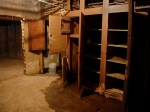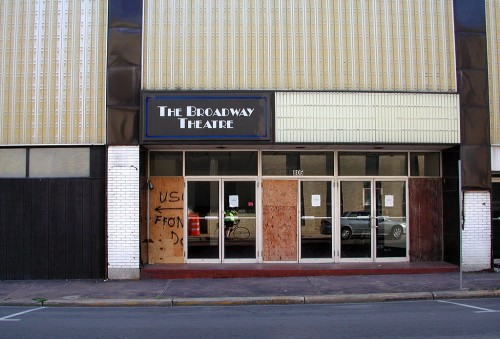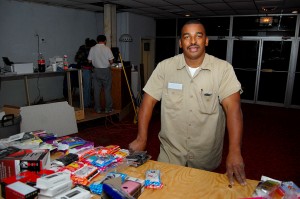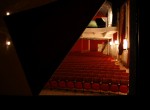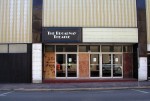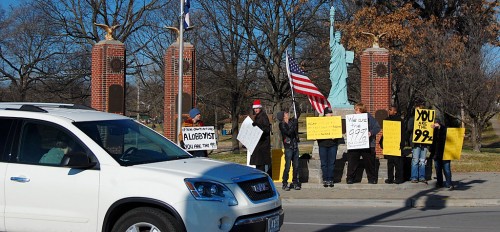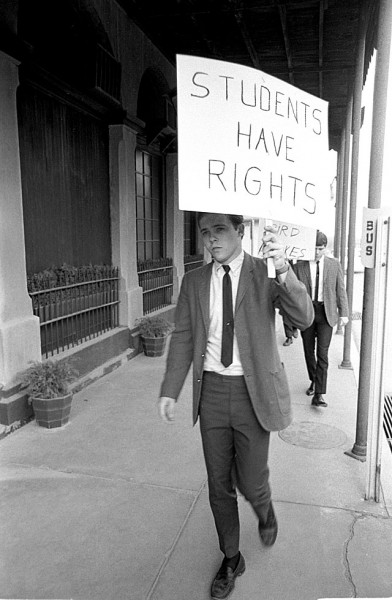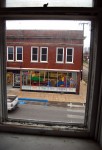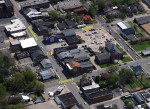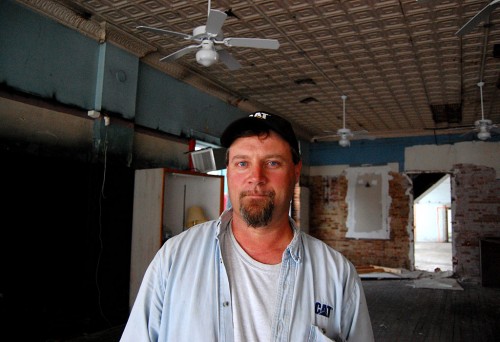 David Renshaw and I didn’t exactly get off on the right foot.
David Renshaw and I didn’t exactly get off on the right foot.
I told Mother I wanted to cruise by 501 Broadway to get a shot of an old building that was due to be torn down. I had photos of it, but I wanted one with the fence around it that would say, “Days are numbered.” I left her in the car with the heater running. (As always, click on any image to make it larger.)
Lutheran Church mural
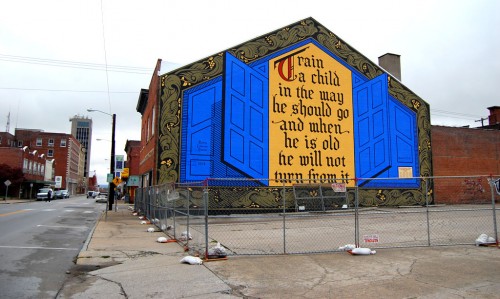 I shot the west side, where the big blue mural is; wandered around to the front; decided I might as well walk down the east side, not because the photos would be all that interesting, but because I wanted some record shots. My eye was drawn to what looked like an enclosed wooden porch on the second floor. In the middle window of the porch was a gold-colored object that looked like it might be a trophy. Curious.
I shot the west side, where the big blue mural is; wandered around to the front; decided I might as well walk down the east side, not because the photos would be all that interesting, but because I wanted some record shots. My eye was drawn to what looked like an enclosed wooden porch on the second floor. In the middle window of the porch was a gold-colored object that looked like it might be a trophy. Curious.
What’s in the window?
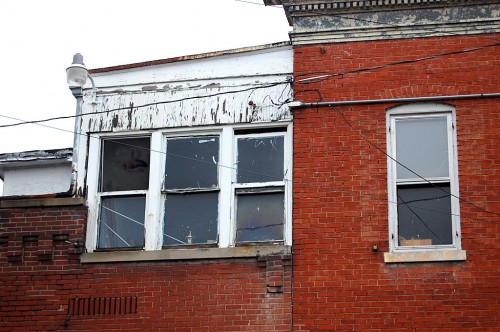 While I was looking at it, I noticed a gap in the fence and a black vehicle pulling into the building through the fence. I decided to “follow that car” to see if I could get some interior shots. I didn’t spot anyone right away, but, walking further in, I ran into a young woman. I handed her my card and started to explain what I was doing when a man walked up asking what I wanted.
While I was looking at it, I noticed a gap in the fence and a black vehicle pulling into the building through the fence. I decided to “follow that car” to see if I could get some interior shots. I didn’t spot anyone right away, but, walking further in, I ran into a young woman. I handed her my card and started to explain what I was doing when a man walked up asking what I wanted.
500 Block of Broadway
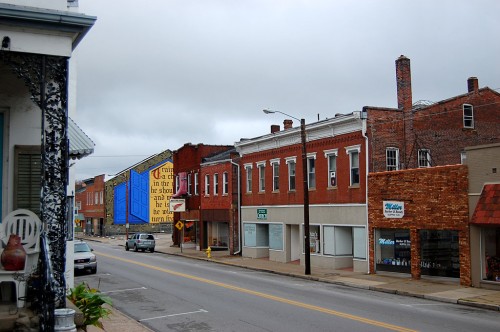 I launched into my standard 30-second elevator speech and got to the part where I said, “I used to work for The Missourian.” That was not a good thing to say because David Renshaw was not happy with part of a Missourian story that morning.
I launched into my standard 30-second elevator speech and got to the part where I said, “I used to work for The Missourian.” That was not a good thing to say because David Renshaw was not happy with part of a Missourian story that morning.
Not happy with Missourian story
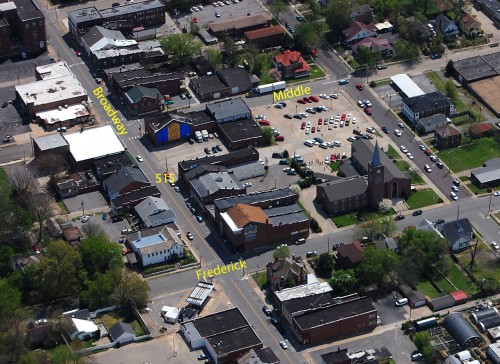 What had his tail twisted was a line in the Nov. 15, 2010, story that said, “[Tim Morgan, director of the city’s Inspection Services Department] and church leaders did not know the exact day the building would come down. But the church has hired Sabre Excavating of Thebes, Ill., to do the work. David Renshaw, of Sabre, did not return phone calls Monday.”
What had his tail twisted was a line in the Nov. 15, 2010, story that said, “[Tim Morgan, director of the city’s Inspection Services Department] and church leaders did not know the exact day the building would come down. But the church has hired Sabre Excavating of Thebes, Ill., to do the work. David Renshaw, of Sabre, did not return phone calls Monday.”
“How could I return a phone call that I didn’t know I’d gotten,” he said, and walked away. Brandy Williams, the young woman clarified. The reporter had called his home number and left a message there. He didn’t get it until much later.
Translating newspaperspeak
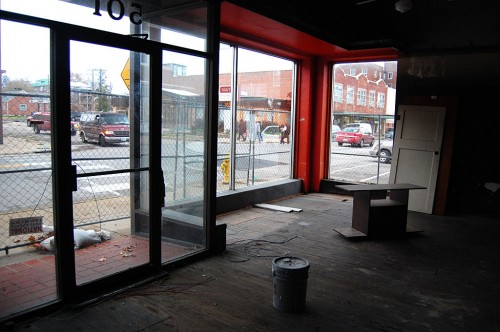 Let me digress here to talk a little about newspaper-speak. In the old days, reporters wrote what information they had and put it into the paper. At some point, people started complaining that, “You didn’t let me tell MY side of the story.” To counter that argument, you started to see some of the following phrases in the paper. How they were interpreted depended a lot on the paper’s policies and local customs.
Let me digress here to talk a little about newspaper-speak. In the old days, reporters wrote what information they had and put it into the paper. At some point, people started complaining that, “You didn’t let me tell MY side of the story.” To counter that argument, you started to see some of the following phrases in the paper. How they were interpreted depended a lot on the paper’s policies and local customs.
- “Refused to comment” – You asked the subject a question and they refused to answer.
- “Not authorized to comment on the record” – That meant you got all kinds of juicy info, but you couldn’t attach the person’s name to it.
- “Didn’t immediately return phone calls” – Now that we’re into 24/7 news cycles, that means, “I was on deadline, called the person, left a message and they didn’t call me back in the five minutes before I had to file this story.”
- “Didn’t return repeated telephone calls” – Subject has been dodging me.
- “Didn’t return repeated calls to his office, home and cell” – Reporter is getting cranky
- “Did not return phone calls” – this was the Renshaw complaint, which I think was valid. The implication was that Renshaw was dodging the call. The reality was that he didn’t KNOW there was a call. That might not have been the reporter’s intent, but that’s the way it was perceived, with reason.
“I’m really not a rude guy”
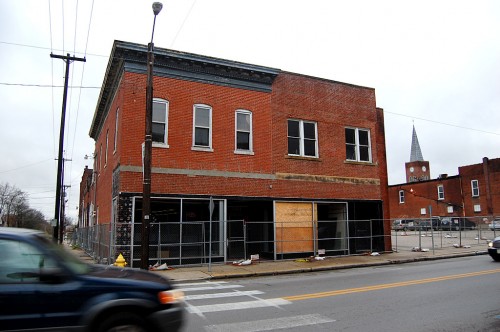 Renshaw came back a couple of minutes later. “I’m not really a rude guy. This just had me a little upset.”
Renshaw came back a couple of minutes later. “I’m not really a rude guy. This just had me a little upset.”
I told him that I was not responsible for anything that happened at The Missourian after 1967. After that, we got along great.
I was discussing interviewing techniques with someone the other day. I said that I approach an interview the same way that I approach fly fishing: I think there’s a big bass hiding under that sunken log and I’ll make a test cast to test my theory. If I’m lucky, I’ve landed a lunker. More than likely, my question won’t get a nibble, so I’ll cast another one. If I’ve tried two or three casts without a nibble, I’ll switch bait and fling it again.
Piercing blue eyes
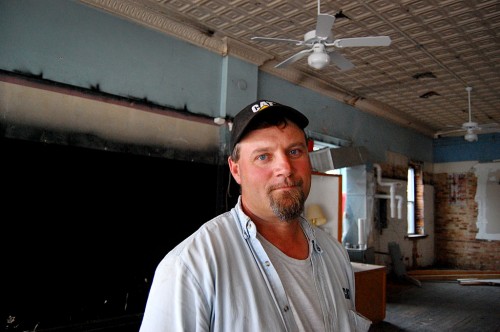 Renshaw has these piercing blue eyes and a bemused expression that deliver the message, “That was a really dumb question” without him having to say a word. He’s the big bass under the log who can’t be fooled with artificial lures.
Renshaw has these piercing blue eyes and a bemused expression that deliver the message, “That was a really dumb question” without him having to say a word. He’s the big bass under the log who can’t be fooled with artificial lures.
Like he said, he’s not a rude guy, but I get the feeling he doesn’t suffer fools kindly.
One the other hand, I was impressed with how introspective and how insightful he was. He has a real appreciation for the buildings he’s destroying.
“It’s too far gone”
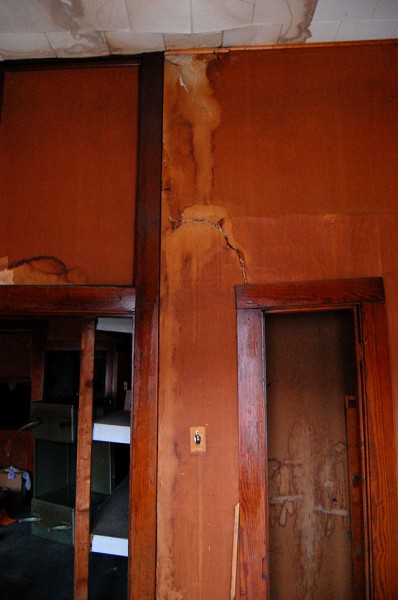 Looking at the tin ceiling on the first floor, with pieces of it falling down and with water dripping from it, I asked if there was any salvage value to it.
Looking at the tin ceiling on the first floor, with pieces of it falling down and with water dripping from it, I asked if there was any salvage value to it.
“It would mean something to someone,” he said, picking up a rusted and rotten piece from the floor. “But, you can’t save it. It’s too far gone. What are you going to do with it?
“I worked for a demolition contractor in St. Louis for eight years, then I came home. That’s my dad in there knocking stuff down. I just wanted to come home.”
Are the bricks worth anything?
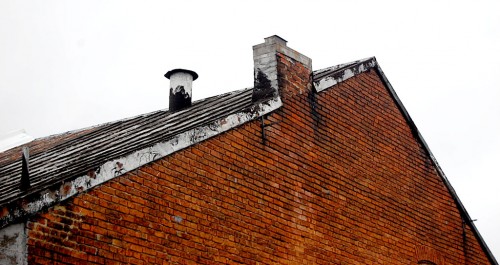 “I can’t get anyone to come get them. I’ve called and I’ve called and I’ve called. If I clean them and pallet them up, I might get 30 cents up to two bucks a brick, but they’ve got to be the right brick. The guy’s wife has to like it.
“I can’t get anyone to come get them. I’ve called and I’ve called and I’ve called. If I clean them and pallet them up, I might get 30 cents up to two bucks a brick, but they’ve got to be the right brick. The guy’s wife has to like it.
“Brick places want you to take some bricks and lay them out to take a pretty picture, flip ’em over and take another picture, flip ’em over and take another picture, flip ’em over and take another picture. That’s six bricks out of how many there are in here?
“We did it on one project and we didn’t make anything – maybe $25 a pallet. I don’t have a place to store it.”
“I cut every section of that bridge”
 He looked at my business card that has a photo of the old Mississippi River Bridge on it. “I cut every section of that bridge with a huge pair of metal shears. I did that. I was handing out handfuls of rivets to people for souvenirs. I still have some pieces of the debris.
He looked at my business card that has a photo of the old Mississippi River Bridge on it. “I cut every section of that bridge with a huge pair of metal shears. I did that. I was handing out handfuls of rivets to people for souvenirs. I still have some pieces of the debris.
Then, he told me a touching story. “I remember when I was first getting started out in Operators. I had a bunch of [union] stickers. I was stuck in traffic on the bridge with my son, who was about eight or nine. There wasn’t anything to do, so I gave him some stickers and he started sticking them on the side of the bridge – Ironworkers stickers – just sticking them on the side of the bridge.
“And, when I was cutting that bridge up, when I got to that piece of the bridge, the stickers were still there. I cut it out and kept it. My son’s 21 now.”
Mortar has turned to powder
 “I think the best thing you can do to this building is to tear it down. There’s nothing here.”
“I think the best thing you can do to this building is to tear it down. There’s nothing here.”
He pointed out obvious cracks in the walls. There are metal bracing bolts coming through the brick wall the mural is painted on, but there are no plates screwed to them. There are places where the mortar has been patched, but most of the mortar is so powdery that you can dig it out with your fingernail with no effort.
Roof is leaking
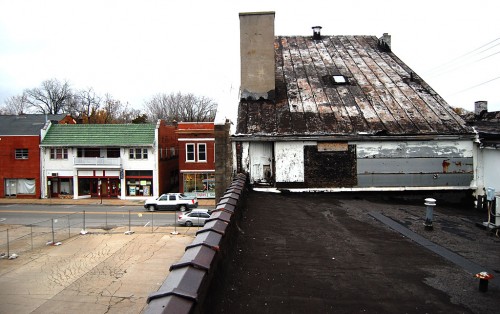 When we walked across the roof, I commented that it didn’t look too bad. He said the leaks aren’t obvious. “You saw the water pouring down through the ceiling. The roof is leaking.”
When we walked across the roof, I commented that it didn’t look too bad. He said the leaks aren’t obvious. “You saw the water pouring down through the ceiling. The roof is leaking.”
What I thought was a trophy
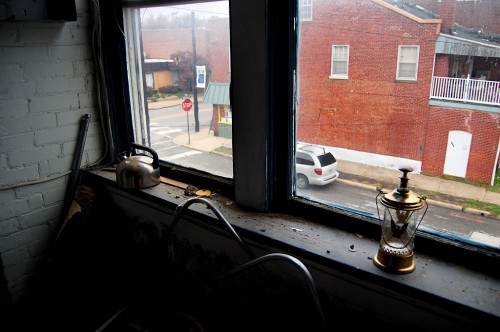 When I asked if it was safe to go up on the second floor, he said he’d be happy to take me up, “but there’s nothing up there but junk”. He thought I might like to go on the roof, though, to shoot the surrounding neighborhood. He said there’s a third floor to the building, but the access to it is boarded up. He didn’t know what, if anything, was up there.
When I asked if it was safe to go up on the second floor, he said he’d be happy to take me up, “but there’s nothing up there but junk”. He thought I might like to go on the roof, though, to shoot the surrounding neighborhood. He said there’s a third floor to the building, but the access to it is boarded up. He didn’t know what, if anything, was up there.
It WAS junk
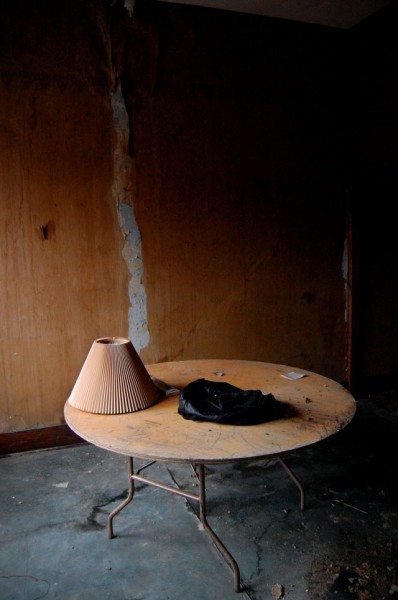 When we got to the second floor, he was right. Whoever had lived in the two apartments there had left behind plenty of debris, but most of it wasn’t very interesting: just some old books, a couple of Samsonite suitcases – “We had a Vietnam vet up here the other day; he remembered carrying suitcases that looked like that” – a pair of crutches and some ratty furniture.
When we got to the second floor, he was right. Whoever had lived in the two apartments there had left behind plenty of debris, but most of it wasn’t very interesting: just some old books, a couple of Samsonite suitcases – “We had a Vietnam vet up here the other day; he remembered carrying suitcases that looked like that” – a pair of crutches and some ratty furniture.
“This is going to be gone forever”
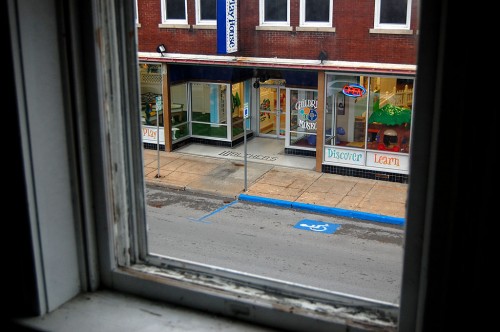 Like I wrote yesterday, just I started to walk out of the room, I turned and said, “I guess I should get a picture of the building across the street. It may be the last picture ever taken with this viewpoint.”
Like I wrote yesterday, just I started to walk out of the room, I turned and said, “I guess I should get a picture of the building across the street. It may be the last picture ever taken with this viewpoint.”
That’s when Renshaw said something that struck me enough that it’s worth repeating: “I learned one thing in demolition – and I look at it from a lot of different ways. This is it. You just said it. This is going to be gone forever. Gone. No more. Right now you just experienced the last thing forever.
“There was a four-year-old little boy up here this morning – his dad is in this kind of work – and he was standing here leaning on this windowsill wanting to go back over there [to the Playhouse]. When he’s 20 years old, he won’t even remember this building.”
View from Discovery Playhouse
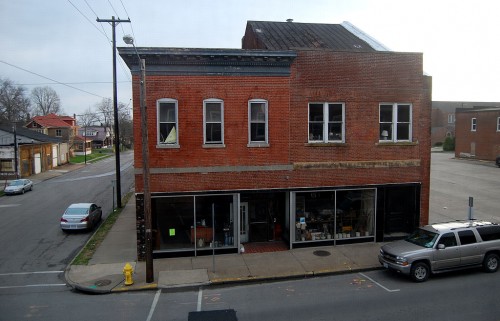 He thinks the building will start coming down around the first of December. “It should go fast, then the trucks will start rolling in here. That’s when people will really start taking note. They really don’t know something’s going on until that.”
He thinks the building will start coming down around the first of December. “It should go fast, then the trucks will start rolling in here. That’s when people will really start taking note. They really don’t know something’s going on until that.”
Cape firefighters took advantage of the soon-to-be demolished building to practice some of their skills. Missourian photographer Fred Lynch captured a gallery of photos of their training.
“A Time to Build Up; A Time to Tear Down”
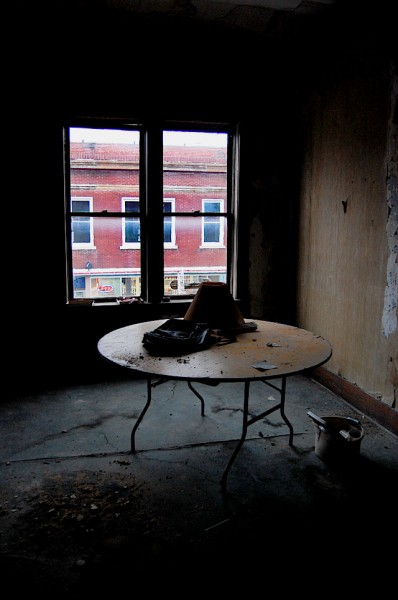 Reader Lyndel Revelle commented yesterday, “It is sad to see them gone forever but then it reminds me of the Byrds song, Turn, Turn ,Turn, (taken from the book of Ecclesiastes) where you find these words, ‘To everything there is a season a time for every purpose under heaven: a time to build up and a time to tear down.’”
Reader Lyndel Revelle commented yesterday, “It is sad to see them gone forever but then it reminds me of the Byrds song, Turn, Turn ,Turn, (taken from the book of Ecclesiastes) where you find these words, ‘To everything there is a season a time for every purpose under heaven: a time to build up and a time to tear down.’”
501-503 Broadway Photo Gallery
Here’s a gallery of photos I’ve taken of 501-503 Broadway and its neighbors over the past few years. Click on any image to make it larger, then click on the left or right side to move through the gallery.
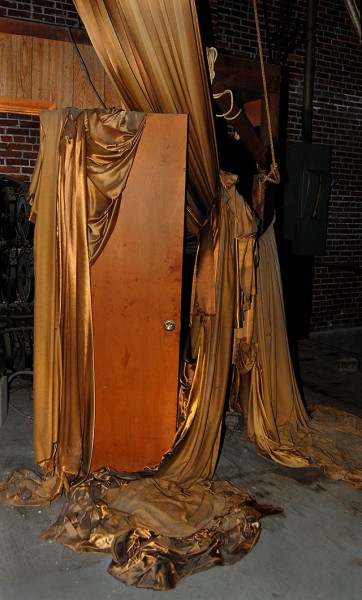 Yesterday you saw the public areas of Broadway Theater. Today we’ll go backstage and into the dressing rooms and basement areas. [Note: the photos are dated 12/16/2010. They should have been marked 2011. That’s what happens when you are working at 3 in the morning. Thanks to Gail Jackson Brown for pointing that out.]
Yesterday you saw the public areas of Broadway Theater. Today we’ll go backstage and into the dressing rooms and basement areas. [Note: the photos are dated 12/16/2010. They should have been marked 2011. That’s what happens when you are working at 3 in the morning. Thanks to Gail Jackson Brown for pointing that out.]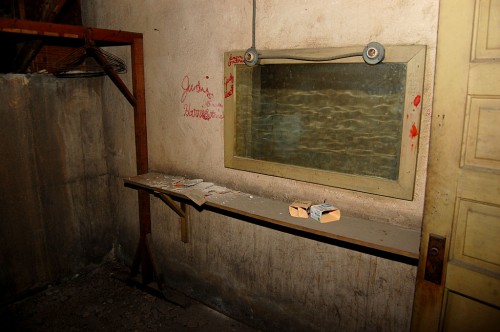 A lot of old theaters I’ve been in have autographs of actors scrawled all over the walls backstage and in the dressing rooms. The only marks I could see here looked like they might have done recently with lipstick.
A lot of old theaters I’ve been in have autographs of actors scrawled all over the walls backstage and in the dressing rooms. The only marks I could see here looked like they might have done recently with lipstick.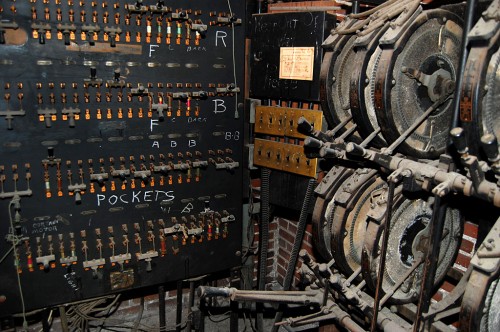 These knife switches and huge rheostats were used to control stage lighting.
These knife switches and huge rheostats were used to control stage lighting.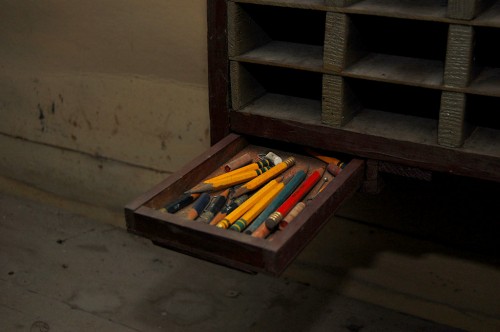 I think this is my favorite photo from Down Below. This drawer of pencils was pulled out over what I assume to have been a work bench. Some of the pencil stubs weren’t over an inch long. THERE’S a guy who didn’t waste anything.
I think this is my favorite photo from Down Below. This drawer of pencils was pulled out over what I assume to have been a work bench. Some of the pencil stubs weren’t over an inch long. THERE’S a guy who didn’t waste anything.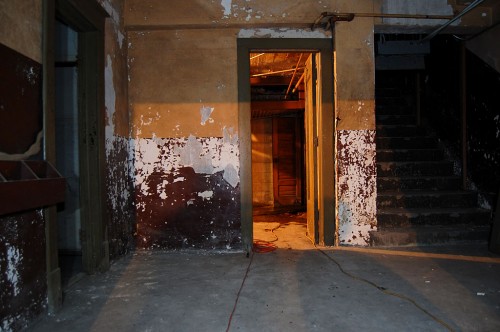 I’ll go to about any length to keep from using flash. I’m not very good at it and I don’t have the equipment to do it right. Sometimes, though, you have to shoot where there’s no available light available.
I’ll go to about any length to keep from using flash. I’m not very good at it and I don’t have the equipment to do it right. Sometimes, though, you have to shoot where there’s no available light available.













